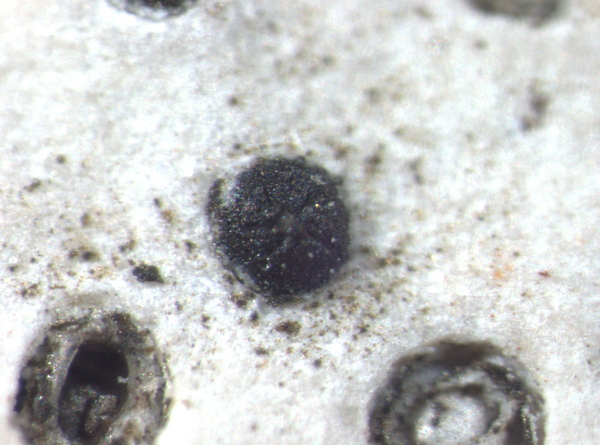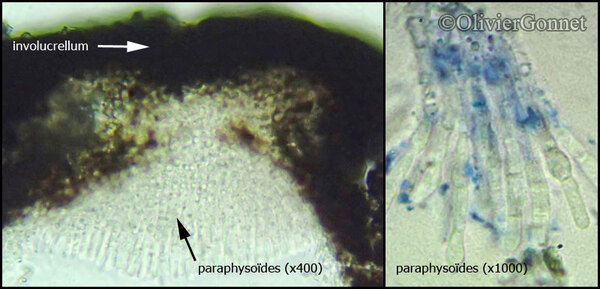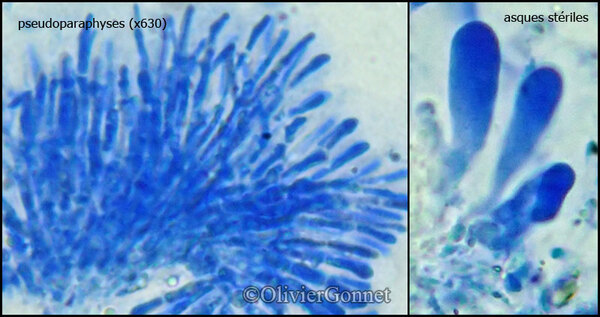Bagliettoa parmigera (J. Steiner) Vězda & Poelt
in Poelt & Vezda, Bibl. Lichenol., 16: 363, 1981. Basionym: Verrucaria parmigera J. Steiner - Verh. zool.-bot. Ges. Wien, 61: 34, 1911.
Synonyms: Amphoridium saxivorum (Servít) Grummann; Protobagliettoa parmigera (J. Steiner) Servít; Verrucaria gyelnikii Servít; Verrucaria parmigera f. subconcentrica J. Steiner; Verrucaria saxivora Servít; Verrucaria subconcentrica (J. Steiner) Servít
Distribution: N - VG (Castello 2002, Martellos & Castello 2004, Cucchi & al. 2009b), Frl (Nimis & Salvadori 1998, Nascimbene & Salvadori 2008, Nascimbene & al. 2009b), Ven (Caniglia & al. 1999, Nascimbene & Salvadori 2008), TAA (De Benetti & Caniglia 1993, Nascimbene 2005b), Lomb, Piem (Isocrono & al. 2004), VA (Piervittori & Isocrono 1999), Emil (Fariselli & al. 2020), Lig (Valcuvia & al. 2000, Giordani & al. 2016, 2025). C - Tosc (Brackel 2015), Marc (Nimis & Tretiach 1999), Umb (Nimis & Tretiach 1999, Ravera & al. 2006, Genovesi 2011), Laz (Nimis & Tretiach 2004, Brackel 2015), Abr (Nimis & Tretiach 1999, Gheza & al. 2021), Mol (Garofalo & al. 1999, Caporale & al. 2008, Nimis & Tretiach 1999), Sar (Rizzi & al. 2011). S - Camp (Garofalo & al. 1999, 2010, Altieri & al. 2000, Aprile & al. 2003, 2003b, Nimis & Tretiach 2004, Roccardi & Ricci 2006, Bertuzzi & al. 2011, Tretiach & al. 2011c), Pugl (Garofalo & al. 1999, Nimis & Tretiach 1999, Durini & Medagli 2004, Brackel 2011), Bas (Nimis & Tretiach 1999), Cal (Puntillo 1996), Si (Nimis & al. 1994, 1996b, Ottonello & Salone 1994, Ottonello & al. 1994, Monte & Ferrari 1996, Ottonello 1996, Grillo 1998, Grillo & al. 2001, 2002, 2009, Grillo & Caniglia 2004, Caniglia & Grillo 2005, 2006, Liistro & Cataldo 2011, Cataldo & Cannavò 2014).
Description: Thallus crustose, fully endosubstratic, usually covering large surfaces, white to pale grey, often delimited from adjacent thalli by a dark prothalline line. Cortex (lithocortex) densely prosoplectenchymatous, of conglutinated hyphae intermingled with microcrystals; algal layer discontinuous, the photobiont cells in clusters; medulla prosoplectenchymatous, with oil cells (macrosphaeroids) in lower part. Perithecia black, numerous, completely immersed in thallus and leaving deep pits in the rock when they fall off. Involucrellum black, disc-shaped, with radial cracks around the ostiole, c. as large as or slightly larger than exciple (0.2-0.3 mm); exciple entirely colourless to dark throughout; hymenial gel hemiamyloid, I+ red (I+ blue at very low concentrations of I), K/I+ blue; hamathecium of periphyses in the ostiolar canal, and short periphysoids in the upper half of the perithecial cavity; paraphyses dissolving early. Asci 8-spored, two-layered, fissitunicate, with a thin tholus reacting I-, Verrucaria-type. Ascospores 1-celled, hyaline, ellipsoid, often poorly developed, 13-26 x 7-15 µm. Photobiont chlorococcoid. Spot tests: K-, C-, KC-, P-, UV-. Chemistry: without lichen substances. Note: a mainly mild-temperate lichen found on compact limestone and in exposed situations, with optimum in the submediterranean belt; albeit rarely, it also occurs in disturbed habitats (e.g. on monuments in Rome).
Growth form: Crustose endolithic
Substrata: rocks
Photobiont: green algae other than Trentepohlia
Reproductive strategy: mainly sexual
Commonnes-rarity: (info)
Alpine belt: absent
Subalpine belt: extremely rare
Oromediterranean belt: rare
Montane belt: common
Submediterranean belt: extremely common
Padanian area: rare
Humid submediterranean belt: extremely common
Humid mediterranean belt: rather common
Dry mediterranean belt: rare

Predictive model
Herbarium samples
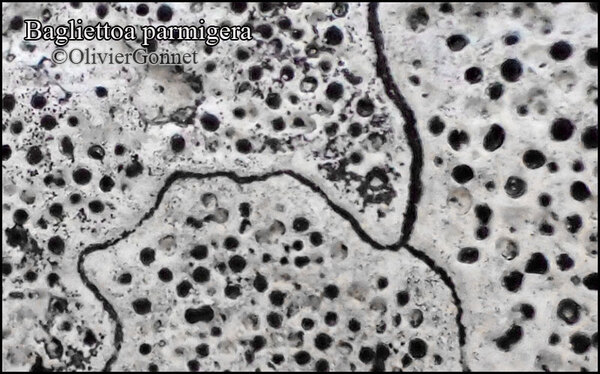
Courtesy Danièle et Olivier Gonnet - Source: https://www.afl-lichenologie.fr/Photos_AFL/Photos_AFL_B/Textes_B2/Bagliettoa_parmigera.htm
France, session 2015 en Bourgogne - sur roche calcaire - Côte-d'Or
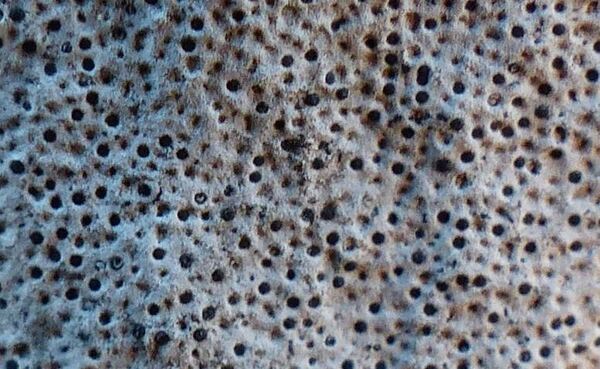

Andrea Moro; Owner: Department of Life Sciences, University of Trieste
italy, Friuli Venezia Giulia, Trieste, Trieste Karst near Borgo Grotta Gigante
16/02/2017
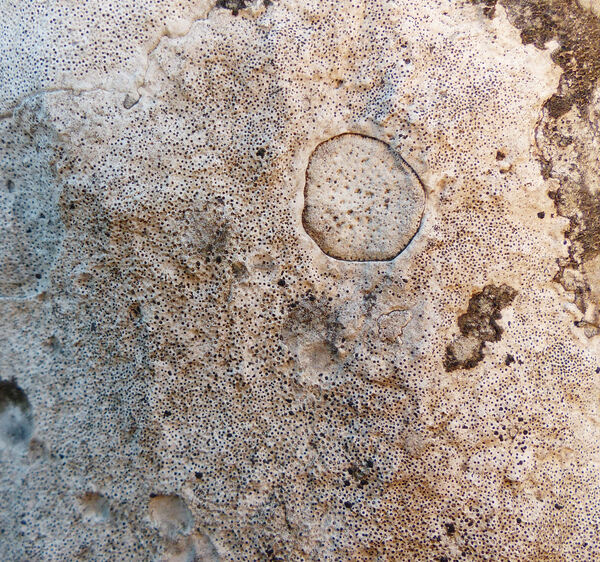

Andrea Moro; Owner: Department of Life Sciences, University of Trieste
italy, Friuli Venezia Giulia, Trieste, Trieste Karst near Borgo Grotta Gigante
16/02/2017
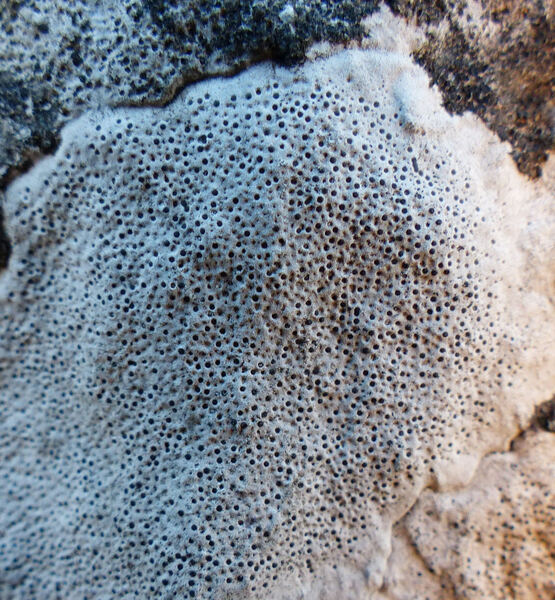

Andrea Moro; Owner: Department of Life Sciences, University of Trieste
italy, Friuli Venezia Giulia, Trieste, Trieste Karst near Borgo Grotta Gigante
16/02/2017
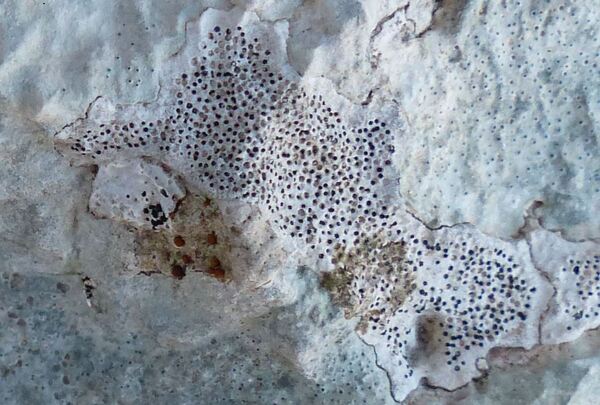

Andrea Moro; Owner: Department of Life Sciences, University of Trieste
italy, Friuli Venezia Giulia, Trieste, Trieste Karst near Borgo Grotta Gigante
16/02/2017
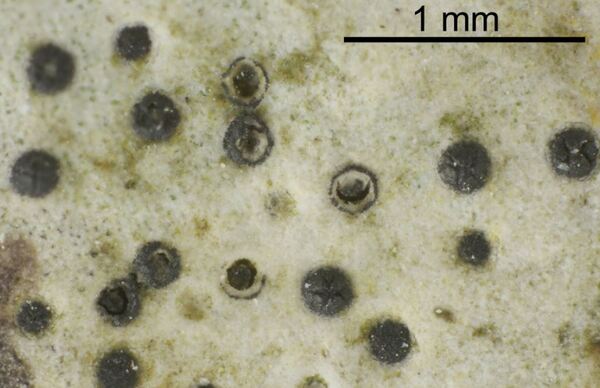

Felix Schumm – CC BY-SA 4.0
[16566], Germany, Baden-Württemberg, Kreis Göppingen, Messelstein bei Donzdorf, 48,69045° N, 9,83113° E, 750 m. An schattigem Kalkblock. Leg. et det. Schumm 26.07.2010, test. A. Aptroot 2011


Felix Schumm – CC BY-SA 4.0
[16566], Germany, Baden-Württemberg, Kreis Göppingen, Messelstein bei Donzdorf, 48,69045° N, 9,83113° E, 750 m. An schattigem Kalkblock. Leg. et det. Schumm 26.07.2010, test. A. Aptroot 2011
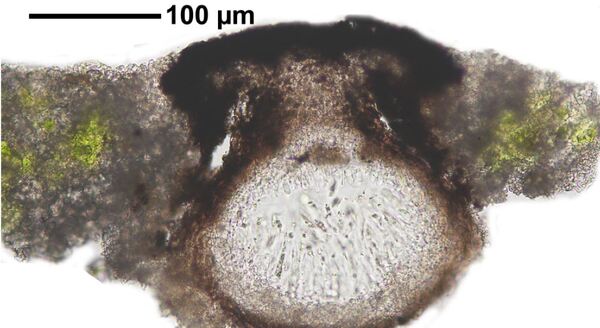

Felix Schumm – CC BY-SA 4.0
[16566], Germany, Baden-Württemberg, Kreis Göppingen, Messelstein bei Donzdorf, 48,69045° N, 9,83113° E, 750 m. An schattigem Kalkblock. Leg. et det. Schumm 26.07.2010, test. A. Aptroot 2011
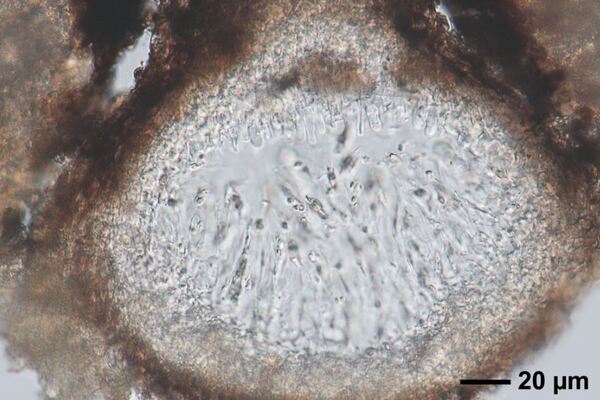

Felix Schumm – CC BY-SA 4.0
[16566], Germany, Baden-Württemberg, Kreis Göppingen, Messelstein bei Donzdorf, 48,69045° N, 9,83113° E, 750 m. An schattigem Kalkblock. Leg. et det. Schumm 26.07.2010, test. A. Aptroot 2011


Felix Schumm – CC BY-SA 4.0
[16566], Germany, Baden-Württemberg, Kreis Göppingen, Messelstein bei Donzdorf, 48,69045° N, 9,83113° E, 750 m. An schattigem Kalkblock. Leg. et det. Schumm 26.07.2010, test. A. Aptroot 2011
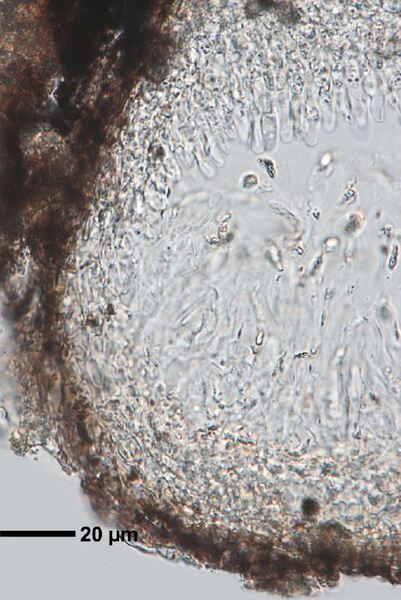

Felix Schumm – CC BY-SA 4.0
[16566], Germany, Baden-Württemberg, Kreis Göppingen, Messelstein bei Donzdorf, 48,69045° N, 9,83113° E, 750 m. An schattigem Kalkblock. Leg. et det. Schumm 26.07.2010, test. A. Aptroot 2011
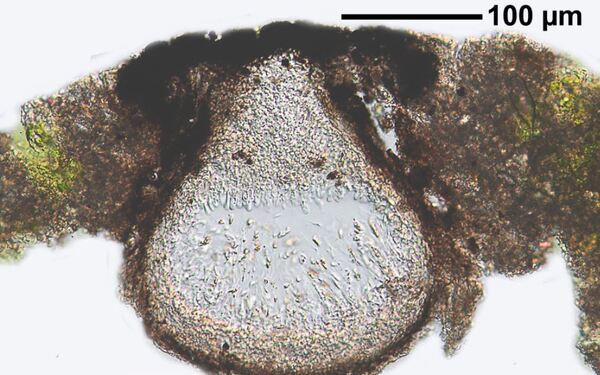

Felix Schumm – CC BY-SA 4.0
[16566], Germany, Baden-Württemberg, Kreis Göppingen, Messelstein bei Donzdorf, 48,69045° N, 9,83113° E, 750 m. An schattigem Kalkblock. Leg. et det. Schumm 26.07.2010, test. A. Aptroot 2011
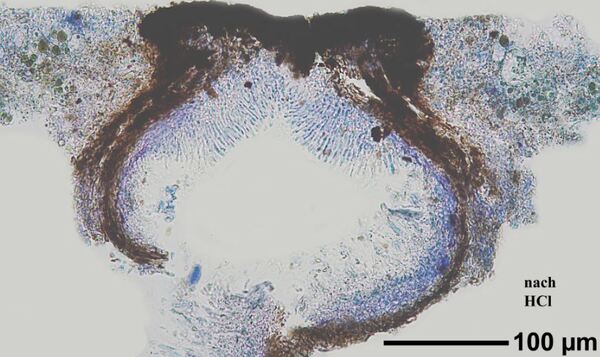

Felix Schumm – CC BY-SA 4.0
[16566], Germany, Baden-Württemberg, Kreis Göppingen, Messelstein bei Donzdorf, 48,69045° N, 9,83113° E, 750 m. An schattigem Kalkblock. Leg. et det. Schumm 26.07.2010, test. A. Aptroot 2011
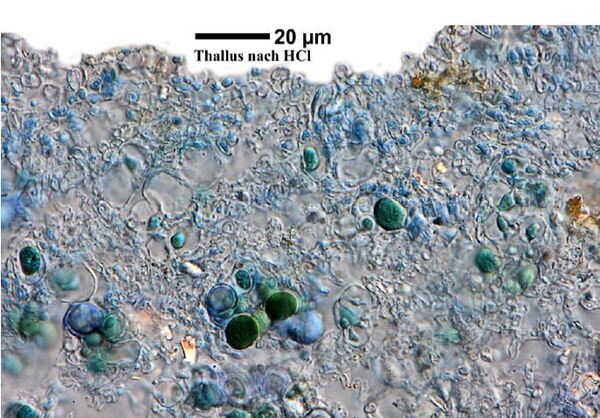

Felix Schumm – CC BY-SA 4.0
[16566], Germany, Baden-Württemberg, Kreis Göppingen, Messelstein bei Donzdorf, 48,69045° N, 9,83113° E, 750 m. An schattigem Kalkblock. Leg. et det. Schumm 26.07.2010, test. A. Aptroot 2011
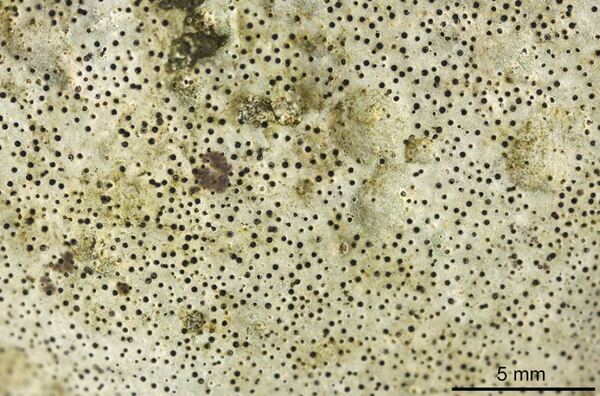

Felix Schumm – CC BY-SA 4.0
[16566], Germany, Baden-Württemberg, Kreis Göppingen, Messelstein bei Donzdorf, 48,69045° N, 9,83113° E, 750 m. An schattigem Kalkblock. Leg. et det. Schumm 26.07.2010, test. A. Aptroot 2011
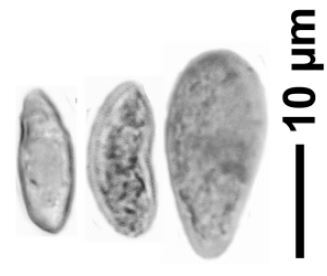

Felix Schumm – CC BY-SA 4.0
[16566], Germany, Baden-Württemberg, Kreis Göppingen, Messelstein bei Donzdorf, 48,69045° N, 9,83113° E, 750 m. An schattigem Kalkblock. Leg. et det. Schumm 26.07.2010, test. A. Aptroot 2011

Zschacke, H. (1934) Epigloeaceae, Verrucariaceae und Dermatocarpaceae. In: Dr. L. Rabenhorst‘s Kryptogamen-Flora, Band 9, Abt. 1, Teil 1. Akademische Verlagsgesellschaft, Leipzig, 695 pp. - Public Domain
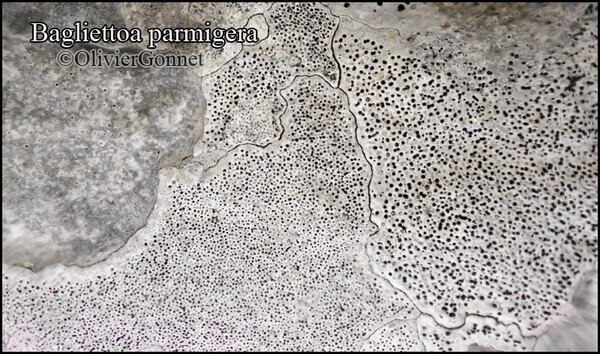
Courtesy Danièle et Olivier Gonnet - Source: https://www.afl-lichenologie.fr/Photos_AFL/Photos_AFL_B/Textes_B2/Bagliettoa_parmigera.htm
France, session 2015 en Bourgogne - sur roche calcaire - Côte-d'Or
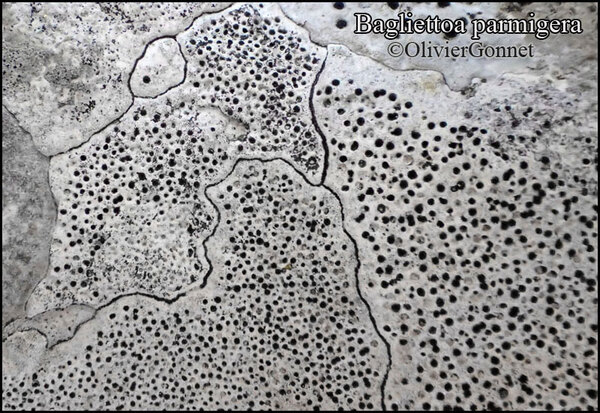
Courtesy Danièle et Olivier Gonnet - Source: https://www.afl-lichenologie.fr/Photos_AFL/Photos_AFL_B/Textes_B2/Bagliettoa_parmigera.htm
France, session 2015 en Bourgogne - sur roche calcaire - Côte-d'Or
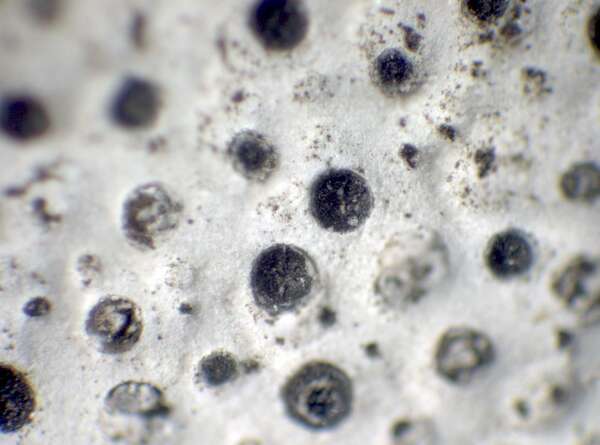

P.L. Nimis; Owner: Department of Life Sciences, University of Trieste
Herbarium: TSB (16904)
2001/11/22

Courtesy Danièle et Olivier Gonnet - Source: https://www.afl-lichenologie.fr/Photos_AFL/Photos_AFL_B/Textes_B2/Bagliettoa_parmigera.htm
France, session 2015 en Bourgogne - sur roche calcaire - Côte-d'Or

Courtesy Danièle et Olivier Gonnet - Source: https://www.afl-lichenologie.fr/Photos_AFL/Photos_AFL_B/Textes_B2/Bagliettoa_parmigera.htm
France, session 2015 en Bourgogne - sur roche calcaire - Côte-d'Or
Growth form: Crustose endolithic
Substrata: rocks
Photobiont: green algae other than Trentepohlia
Reproductive strategy: mainly sexual
Commonnes-rarity: (info)
Alpine belt: absent
Subalpine belt: extremely rare
Oromediterranean belt: rare
Montane belt: common
Submediterranean belt: extremely common
Padanian area: rare
Humid submediterranean belt: extremely common
Humid mediterranean belt: rather common
Dry mediterranean belt: rare

Predictive model
| Herbarium samples |

Courtesy Danièle et Olivier Gonnet - Source: https://www.afl-lichenologie.fr/Photos_AFL/Photos_AFL_B/Textes_B2/Bagliettoa_parmigera.htm
France, session 2015 en Bourgogne - sur roche calcaire - Côte-d'Or


Andrea Moro; Owner: Department of Life Sciences, University of Trieste
italy, Friuli Venezia Giulia, Trieste, Trieste Karst near Borgo Grotta Gigante
16/02/2017


Andrea Moro; Owner: Department of Life Sciences, University of Trieste
italy, Friuli Venezia Giulia, Trieste, Trieste Karst near Borgo Grotta Gigante
16/02/2017


Andrea Moro; Owner: Department of Life Sciences, University of Trieste
italy, Friuli Venezia Giulia, Trieste, Trieste Karst near Borgo Grotta Gigante
16/02/2017


Andrea Moro; Owner: Department of Life Sciences, University of Trieste
italy, Friuli Venezia Giulia, Trieste, Trieste Karst near Borgo Grotta Gigante
16/02/2017


Felix Schumm – CC BY-SA 4.0
[16566], Germany, Baden-Württemberg, Kreis Göppingen, Messelstein bei Donzdorf, 48,69045° N, 9,83113° E, 750 m. An schattigem Kalkblock. Leg. et det. Schumm 26.07.2010, test. A. Aptroot 2011


Felix Schumm – CC BY-SA 4.0
[16566], Germany, Baden-Württemberg, Kreis Göppingen, Messelstein bei Donzdorf, 48,69045° N, 9,83113° E, 750 m. An schattigem Kalkblock. Leg. et det. Schumm 26.07.2010, test. A. Aptroot 2011


Felix Schumm – CC BY-SA 4.0
[16566], Germany, Baden-Württemberg, Kreis Göppingen, Messelstein bei Donzdorf, 48,69045° N, 9,83113° E, 750 m. An schattigem Kalkblock. Leg. et det. Schumm 26.07.2010, test. A. Aptroot 2011


Felix Schumm – CC BY-SA 4.0
[16566], Germany, Baden-Württemberg, Kreis Göppingen, Messelstein bei Donzdorf, 48,69045° N, 9,83113° E, 750 m. An schattigem Kalkblock. Leg. et det. Schumm 26.07.2010, test. A. Aptroot 2011


Felix Schumm – CC BY-SA 4.0
[16566], Germany, Baden-Württemberg, Kreis Göppingen, Messelstein bei Donzdorf, 48,69045° N, 9,83113° E, 750 m. An schattigem Kalkblock. Leg. et det. Schumm 26.07.2010, test. A. Aptroot 2011


Felix Schumm – CC BY-SA 4.0
[16566], Germany, Baden-Württemberg, Kreis Göppingen, Messelstein bei Donzdorf, 48,69045° N, 9,83113° E, 750 m. An schattigem Kalkblock. Leg. et det. Schumm 26.07.2010, test. A. Aptroot 2011


Felix Schumm – CC BY-SA 4.0
[16566], Germany, Baden-Württemberg, Kreis Göppingen, Messelstein bei Donzdorf, 48,69045° N, 9,83113° E, 750 m. An schattigem Kalkblock. Leg. et det. Schumm 26.07.2010, test. A. Aptroot 2011


Felix Schumm – CC BY-SA 4.0
[16566], Germany, Baden-Württemberg, Kreis Göppingen, Messelstein bei Donzdorf, 48,69045° N, 9,83113° E, 750 m. An schattigem Kalkblock. Leg. et det. Schumm 26.07.2010, test. A. Aptroot 2011


Felix Schumm – CC BY-SA 4.0
[16566], Germany, Baden-Württemberg, Kreis Göppingen, Messelstein bei Donzdorf, 48,69045° N, 9,83113° E, 750 m. An schattigem Kalkblock. Leg. et det. Schumm 26.07.2010, test. A. Aptroot 2011


Felix Schumm – CC BY-SA 4.0
[16566], Germany, Baden-Württemberg, Kreis Göppingen, Messelstein bei Donzdorf, 48,69045° N, 9,83113° E, 750 m. An schattigem Kalkblock. Leg. et det. Schumm 26.07.2010, test. A. Aptroot 2011


Felix Schumm – CC BY-SA 4.0
[16566], Germany, Baden-Württemberg, Kreis Göppingen, Messelstein bei Donzdorf, 48,69045° N, 9,83113° E, 750 m. An schattigem Kalkblock. Leg. et det. Schumm 26.07.2010, test. A. Aptroot 2011

Zschacke, H. (1934) Epigloeaceae, Verrucariaceae und Dermatocarpaceae. In: Dr. L. Rabenhorst‘s Kryptogamen-Flora, Band 9, Abt. 1, Teil 1. Akademische Verlagsgesellschaft, Leipzig, 695 pp. - Public Domain

Courtesy Danièle et Olivier Gonnet - Source: https://www.afl-lichenologie.fr/Photos_AFL/Photos_AFL_B/Textes_B2/Bagliettoa_parmigera.htm
France, session 2015 en Bourgogne - sur roche calcaire - Côte-d'Or

Courtesy Danièle et Olivier Gonnet - Source: https://www.afl-lichenologie.fr/Photos_AFL/Photos_AFL_B/Textes_B2/Bagliettoa_parmigera.htm
France, session 2015 en Bourgogne - sur roche calcaire - Côte-d'Or


P.L. Nimis; Owner: Department of Life Sciences, University of Trieste
Herbarium: TSB (16904)
2001/11/22

Courtesy Danièle et Olivier Gonnet - Source: https://www.afl-lichenologie.fr/Photos_AFL/Photos_AFL_B/Textes_B2/Bagliettoa_parmigera.htm
France, session 2015 en Bourgogne - sur roche calcaire - Côte-d'Or

 INDEX FUNGORUM
INDEX FUNGORUM
 GBIF
GBIF
 DOLICHENS
DOLICHENS
